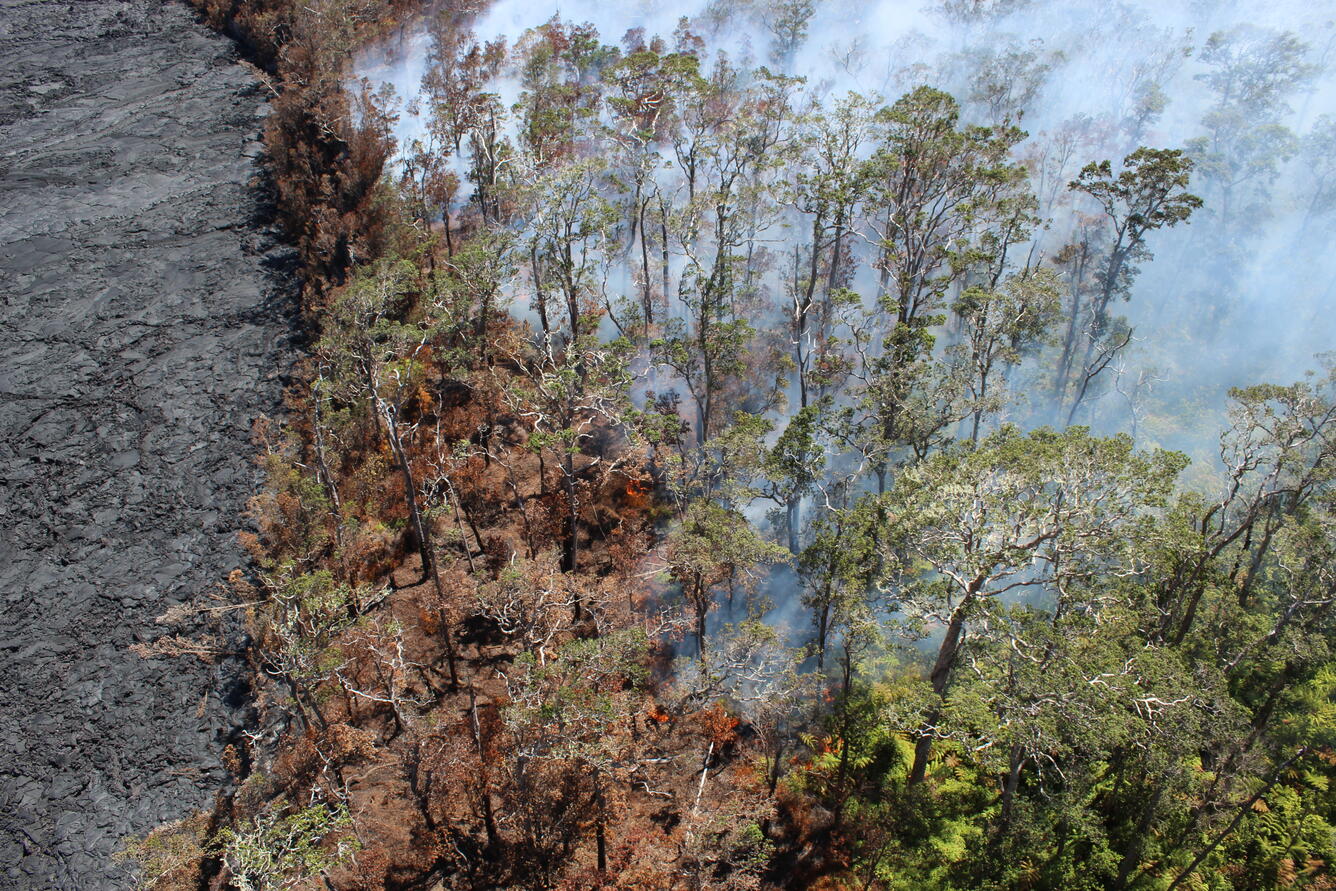 |
| On the middle East Rift Zone of Kīlauea, a recent eruption covered a large portion of the Nāpau Crater floor with new lava—dark gray lava near center of image. This eruption started a forest fire that continues to burn vegetation along the southern rim of Nāpau Crater. Photo view looking northwest with Kānenuiohamo visible in the upper left. USGS photo taken on Oct. 7 by L. DeSmither |
TO SUPPRESS WILDFIRES, MANAULA AND NĀPAU TRAIL PARKING LOTS ARE CLOSED temporarily in Hawai'i' Volcanoes National Park. The areas are off limits to vehicles, pedestrians and cyclists.
The remote 78-acre Makaopuhi Fire was ignited by the September 15 eruption of Kīlauea volcano. Fire activity has increased due to lack of recent rainfall, low humidity and wind. Twenty-two members of the Pacific Islands Fire Management team, which includes firefighters from Hawaiʻi Island and American Sāmoa, are constructing a fire line to gain control of the fire's spreading perimeter. Firefighters are supported by helicopter water drops. A staging area, helispot and temporary dip site are located near the Maunaulu parking lot.
The fire was located on the south rim of Nāpau Crater following the recent eruption on Kīlauea’s middle East Rift Zone, within Hawai‘i Volcanoes National Park. Beginning around 4 p.m. HST on Oct. 6, a smoke plume from the burning vegetation became visible in HVO webcam imagery, and intermittent incandescence was seen overnight. There were no indications of renewed eruptive activity from geophysical monitoring signals. On Oct. 7, an overflight confirmed that the smoke and glow were due to a forest fire.
The temporary closure at Maunaulu is expected to last through Wednesday, Oct, 9 but could be extended if fire spread continues. The fire, which does not have a continuous flaming front, continues to burn pockets of uluhe fern and other vegetation dried by recent volcanic activity in Hawaiʻi Volcanoes National Park. It poses no threat to homes at this time.
The fire is a threat to Hawaiian ecosystems and rare plants in the area. The remote location and the hazardous volcanic terrain in Kīlauea volcano's remote East Rift Zone increase the difficulty of fire suppression efforts.
 | ||
| A wildfire started by a lava flow has drawn firefighters from American Samoa and Hawai'i Island. Photo by L. DeSmither |
To read comments, add your own, and like this story, see facebook.com/kaucalendar. See upcoming events, print edition and archive at kaunews.com.
UP TO THREE ADDITIONAL HOUSING UNITS WILL BE ALLOWED ON EACH LOT to address the housing shortage on the island. Mayor Mitch Roth announced the signing of County Council Bill 123 on Tuesday. It's a piece of legislation aimed at increasing housing inventory on residential and agriculture properties across Hawai'i County. The bill, co-drafted by Council Chair Heather Kimball, Councilwoman Ashley Kierkiewicz, Planning Director Zendo Kern, and Deputy Director Jeff Darrow, allows homeowners to build up to three accessory dwelling units (ADUs) with a size limit of 1,250 sf on their properties, helping address the county's housing shortage and enabling local families to stay in Hawai'i.
"Bill 123 is a significant step toward expanding housing opportunities on Hawaiʻi Island," said Kierkiewicz. "By allowing more ADUs in urban areas, we're encouraging smart growth within our communities. This practical solution not only increases housing availability, but also empowers residents to actively contribute to addressing our island's housing shortage."
"Hawaiʻi County is leading the way with Bill 123. ADUs offer a flexible and affordable housing solution for our residents," said Kimball. "Building ADUs for parents, children or long-term renters can help families stay together here on the island and can help homeowners generate extra income needed to get by. By encouraging development of existing properties in urban areas close to school, work, and commercial areas, ADUs also promote more sustainable land use practices outside the urban core."
The Mayor's announcement said the bill introduces new provisions that replace previous restrictions on "ʻohana dwelling units," providing more flexibility for homeowners to add ADUs. Key amendments include:
Allowing ADUs, whether detached or attached, to be built alongside single-family homes in Residential (RS), Duplex (RD), Residential-Agricultural District (RA), Agricultural (A), and Family Agricultural (FA) districts.
Limiting each property to a maximum of three ADUs.
Ensuring compliance with infrastructure and safety standards, including requirements for sewage disposal and water supply.
Restricting the use of ADUs for transient accommodations, with limited exceptions.
"The ability to build additional dwellings on existing properties is essential in addressing our housing shortage, but it's also about preserving our communities and ensuring that future generations—our keiki—can continue to live and thrive here in Hawai'i," said Roth. "This bill expands our housing inventory in a way that is both sustainable and community-centered."
The statement said Bill 123 reflects Hawai'i County's commitment to tackling the housing crisis while promoting long-term stability and sustainability.
For more information on the new ADU provisions or to learn how to apply for building permits, contact the Planning Department at planning@hawaiicounty.gov.
To read comments, add your own, and like this story, see facebook.com/kaucalendar. See upcoming events, print edition and archive at kaunews.com.






.jpg)